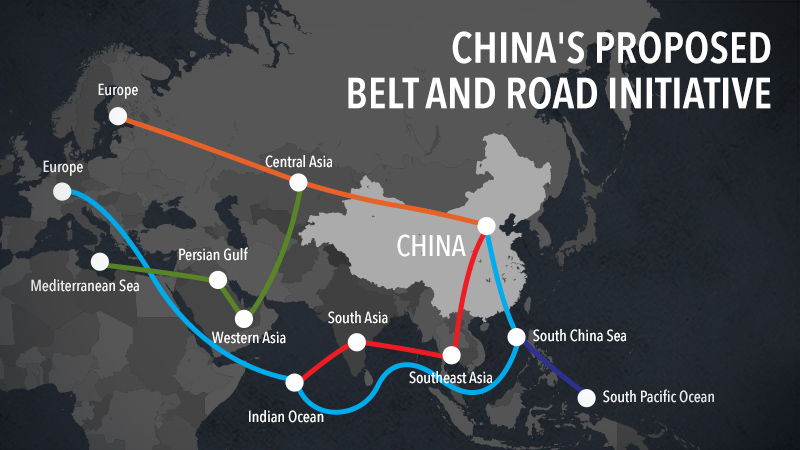Oil and War
In this article by Captain Paul E. Mawn USN (Retired), the author looks at the evolution since World War I of the energy factor in conflicts.
Energy is a key element driving conflict and fueling it as well.
World War 1: The “Oily” Beginning
Oil became a key factor in military might in the decade before World War 1 when the UK Royal Navy and US Navy shifted from coal to oil as a source of power which was soon emulated by other major navies.
By 1939, all naval vessels in the world and 85% of the merchant ships were burning oil for propulsion.
At the start of the 20th century, Russia was the world largest oil producer and responsible for over 50% of the global crude oil production.
However for both geological and political reasons, the Russian oil fields declined significantly right after the Russian Revolution in 1917.
In August 1914 at the start of World War 1, the overseas oil imports for the UK and France came mostly from Iran, Mexico and the USA but German crude oil imports came overland from Romania.
However, the pre-war military logistics strategy of most countries was based on horses and other animals and there was worldwide oil glut since petroleum had few uses beyond making kerosene for lighting.
Furthermore in the “War to end of all Wars”, Henry Ford’s “Model T” was only in the 6th year of production.
Nevertheless, most of the key military innovations used were oil fired such as: submarines, tanks, airplanes and motorized transport.
As trucks replaced horses, airplanes were used initially for reconnaissance which led to fighter planes as a counterforce as well as dropping a few bombs on the enemy while in the air.
The British Army started the war with 250 planes, 26,000 automobiles and 827 motorcycles but had increased to 55,000 planes, 56,000 trucks, 23 automobiles and 34,000 motorcycles by the end of 1918.
During the World War I, 80% of all the Allied petroleum consumption came from the US with the US Navy playing a key role in protecting oil transports to Europe from being sunk by German U boats.
Energy supply before World War II
As shown in figure 1, Germany consumed only 122 MBD* of oil in 1939 since Germany had little crude oil & ample coal production resulting in few private cars and extensive coal fired rail transportation (note: USA oil demand at the time exceeded 3,600 MBD*).
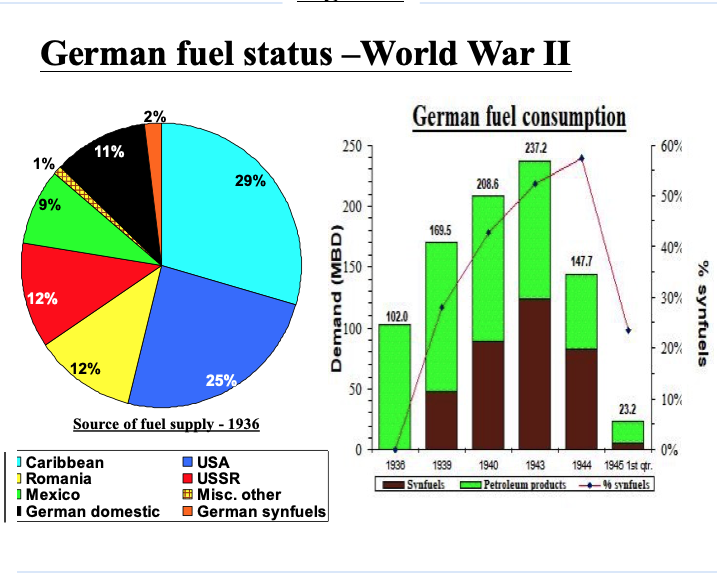
Thus, 63% to 72% of the German oil supply in the mid to late 1930’s arrived via tankers from the Western Hemisphere which was shut off after the start of hostilities in 1939 by a successful Allied Naval blockade.
To compensate for this deficit, 24% of the German oil was imported by barge or rail from Romania, Russia and Austria.
World War II Germany
When Italy invaded Ethiopia In Oct 1935, Mussolini almost faced an oil embargo.
In the following year, the Soviets abruptly shut off delivery of gasoline to their large chain of gasoline stations throughout Germany.
Thus recognizing the key importance of oil, Hitler’s war strategy known as the “blitzkrieg” (i.e. “lightning war”) had to be fierce but short leading to a quick decisive victory before Germany ran out of petroleum.
To this end in the 1930’s, Hitler built an extensive transportation network in Germany with the autobahn for motor vehicles and expanded the rail systems to quickly move Germany troops when required (note: see figure 2).
During the Nazi invasion of Poland which started World War II, Germany had the 15 million barrels (i.e. 121 MBD equivalent or 0.3 days supply) in their strategic oil reserves.
While the 1939 German “blitzkrieg” into Poland worked surprisingly well, this successful non-stop invasion consumed the equivalent of 64% of the total German oil consumption.
In a similar manner, Hitler’s armed forces overran Norway, the Low Countries, and France in the spring of 1940 but were then able to add 5 million barrels of stolen oil (i.e. the equivalent of 5 MBD* or 0.04 days supply) to the German strategic petroleum reserves
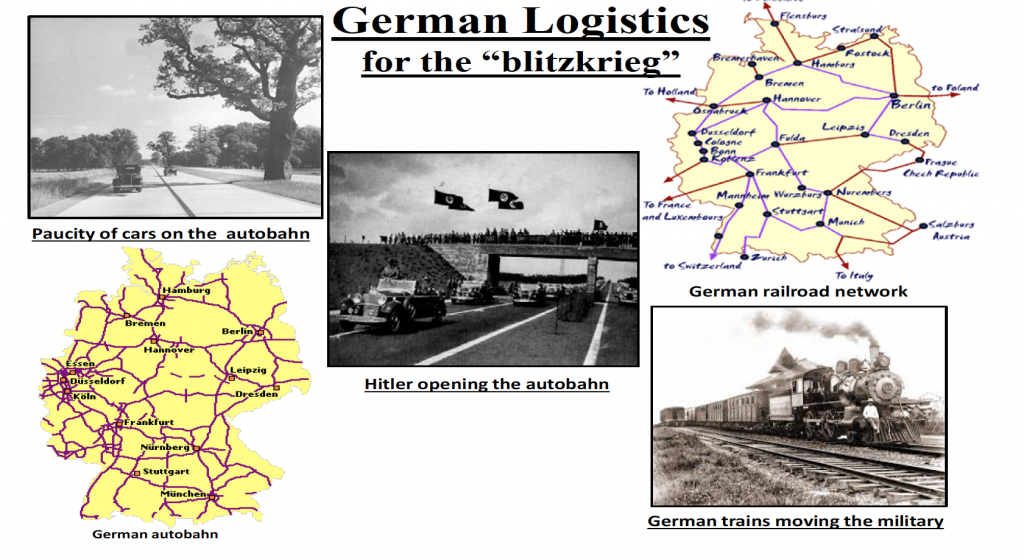
In the fall of 1940, Germany waged a massive aerial bombardment of the British Isles and seemed on the verge of dominance in Europe.
The related German marine strategy was to embargo the United Kingdom of all necessary imports including petroleum with their U- Boat wolf packs under Admiral Doenitz which almost worked.
During the war, U-boats sank over 5,000 allied merchant ships hauling over 12 million tons of cargo which resulted in the loss of over 15,000 merchant seamen.
However, the Brits refused to give up due to their blood, sweat, tears, determination and grit as well as American aid, Navy and Merchant Marine.
The Nazi Grand Strategic Prize
However despite the German-Soviet Nonaggression Pact signed in August of 1939, the invasion of Russia in June 1941 was seen by Hitler as a necessity to meet their anticipated petroleum needs by seizing the oil fields in Baku and the Caucasus. In this attack known as Operation Barbarossa, 3 million German soldiers with 600,000 motor vehicles and 625,000 horses struck along a wide front which caught Stalin off guard, The Germans erroneously believed this new “blitzkrieg” would take less than 10 weeks.
In early 1942, Berlin made plans to subsequently march onwards for the oil in Iran and Iraq and then to India after their capture of the Caucasus. Hitler’s grand strategy was to have one attack through southern Russia and another from the southwest via North Africa (note: see figure 3).
In July 1942, the Germans seemed on their way to achieving that goal and reached the highest point of expansion in the Caucasus and Europe by mid-August.
However these “blitzkrieg” German victories required large amounts of petroleum causing the Nazi’s to outrun their supply lines and lose their advantage of speed and surprise. Thus, this push in Russia for the Caucasus and the quest for oil resulted in the Germans running short of petroleum.
The southern drive to Baku from North Africa was planned almost totally on the new “principle of complete mobility” created by General Erwin Rommel & his “Afrika Korps”. However, this “mobility” warfare also created dangerous vulnerability in supply lines since Rommel was absolutely dependent upon ample supplies of fuel and other vital supplies via a 1,000 miles long supply chain which also consumed a lot of fuel in transportation in addition to their combat needs.
Rommel’s grand goal was to push through Cairo, Palestine, Iraq & Iran on the way to Baku and the Caucasus oil production fields and refineries in the Southeastern part of the Soviet Union.
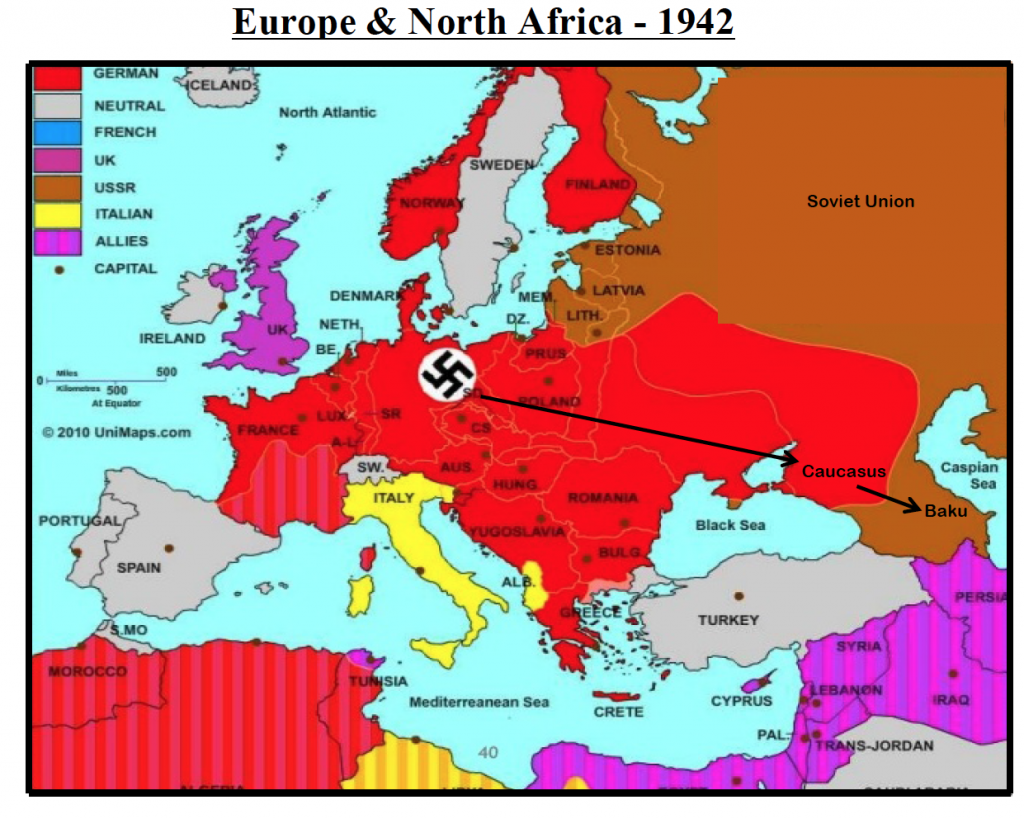
Rommel initially won stunning victories in North Africa against British and later US forces and became known by all as the “Desert Fox”. However at one point, 85% of his transport was provided by captured British and American vehicles and several of the battles were for each other’s fuel dumps. The Axis powers felt they were on the verge of victory until they moved their campaign to Egypt when the Allies started to successfully fend off the German attacks in North Africa. Furthermore, German and Italian military codes were broken that significantly helped in attacking the Axis shipping and supply lines. The British forces capitalized on Rommel’s very long and highly vulnerable supply lines & the Germans essentially ran out of gas.
Thus, oil was a significant factor in the defeat of the Afrika Korps in the desert of North Africa since a large % of the Italian maritime supply convoys were destroyed by British aircraft and submarine attacks based mainly in Malta.
Furthermore, the Germans seriously miscalculated their supply needs as well as the vast size of Russia and the amount & tenacity of Soviet manpower despite the death or capture of almost 8 million Russians killed the 1st year.
As a result, Hitler’s invasion of Russia lasted several months rather than rather the expected several weeks which in turn compounded the severe German shortages of oil and other supplies.
Furthermore, the Luftwaffe calculated a need for 15,000 planes by 1942 to beat Russia which would then consume the equivalent of 60% of the world’s oil production from 1935 to 1936.
However, Nazi Germany could physically not obtain the amount of oil since the USA produced over 59% of the world oil production during the World War II.
With German defeat in North Africa and Russia by mid-1943, Hitler’s dream of capturing the oilfields of Baku and the Caucasus was now a fantasy.
Thus, the German grand strategy eventually failed for several reasons including: Allied attacks on German fuel supply lines, the fierce Russian resistance, and Allied code breakers.
As a result, Germany then faced a huge fuel crisis and turned to focus on coal-based synthetic oil production under the overall direction of Nazi energy Czar field Marshall General Hermann Goëring who was a German Ace fighter pilot in World War I and was also “double hatted” as the head of the Luftwaffe (see figure 4).
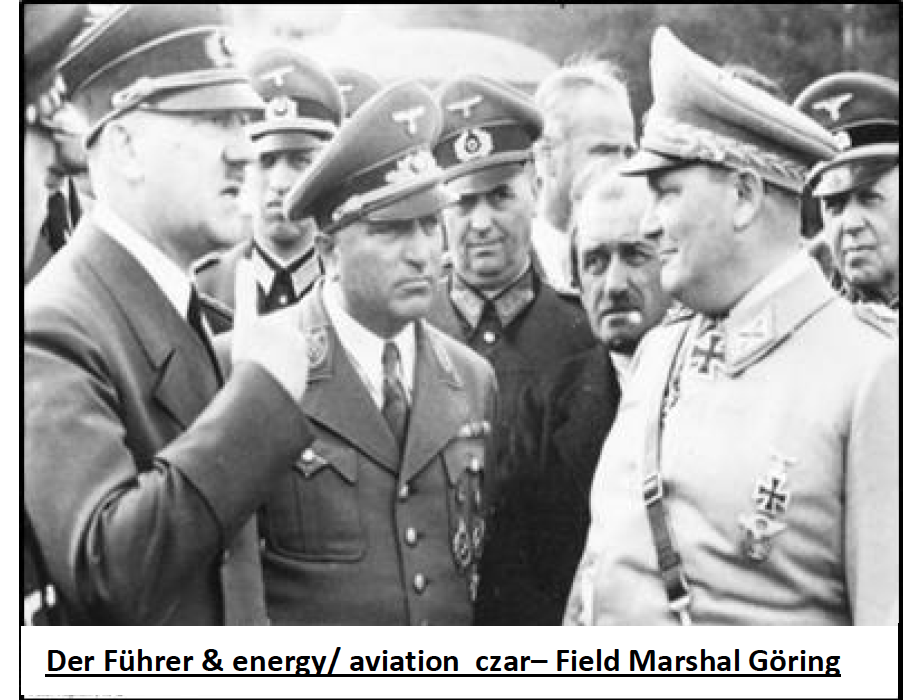
Figure 4
Nazi synthetic oil production
Although Germany did not have much oil, it had abundant coal resources as well as the most advanced chemical industry in the world. At that time, I.G. Farben Company was the world leader in chemistry whose scientists had invented the hydrogenation method to produce high-grade liquid fuel from coal.
In June 1932, Hitler met with the chairman of the Farben Company to discuss the following Nazi media attacks against the company:
- It was a tool of “international financial lords” and “money-mighty Jews” since some Jews held senior positions at I.G.Farben, as well as
- Its avocation and marketing of the expensive project to manufacture synthetic oil from coal.
I.G. Farben argued that synthetic fuels from coal could cut Germany’s dependence on foreign oil and also reduce the pressures on foreign exchange. Hitler was then convinced to endorse the further development of a synthetic oil industry. Since 1921, Standard Oil of New Jersey (SONJ & now ExxonMobil) had unsuccessfully been exploring alternatives to crude oil and viewed the Farben patented technology as a clear threat to its business. As a result, ExxonMobil acquired the Farben patent rights in 1929 for synfuels outside of Germany in exchange for 2% of SONJ’s stock valued at $35 million.
Obviously, ExxonMobil had no need to produce synthetic fuels (i.e. synfuels) because of the oversupply of crude oil at that time and wanted to ensure that each stayed out of the other’s main fields of activity. The US crude surplus and the Great Depression made the synthetic oil production uneconomical and 10 times the price of crude oil from Texas and the other states on the Gulf of Mexico.
However, the aviation fuel potential of hydrogenation won Farben the support of the Luftwaffe and later the German Army which also lobbied on behalf of Farben to ensure that Germany’s oil supply would be adequate for its war plans.
Subsequently, Farben continued as an independent company but in reality became “Nazified” with the removal of all Jewish officials as well as the anti-Nazi chairman, Carl Bosch. When Germany invaded Poland on 1 September 1939, 14 hydrogenation plants were producing almost 72 MBD* or 46% of the total German oil supply & 95% of the total military aviation gasoline.
Between 1940 and 1943, synfuel production almost doubled to 124 MBD* and provided 57% of total German oil consumption including 92% of aviation gasoline and 50% of the German gasoline supply.
However, the synfuel plants were frequently bombed by Allied aircraft and could only produce a low octane fuel which was not good for aircraft without further expensive and time consuming complex refining.
However, the Nazi war economy including the synfuel fuel industry was based on slave labor which made up 33% of the total work force in the German synthetic fuels industry in 1944.
As shown in figure 5, I.G. Farber became an enthusiastic partner with the Nazi SS and operated synthetic fuel and rubber plants adjacent to the Auschwitz and Monowitz death/ concentration camps in Poland which contained over 12,000 inmates as a source of their labor force.

The noose tightens – Nazi Germany runs out of oil and is defeated
Despite all the propaganda about “blitzkrieg”, the day to day mechanics of that German fighting force involved an average of 1.1 million horses throughout World War II. The German Army had the greatest use of equestrian transport during any military conflict in history (note: see figures 6 to 8).
Of the 322 German divisions in 1943, only 52 were armored or motorized.
The German Wehrmacht actually had more veterinarians in uniform than medical doctors and most infantry divisions marched into battle on foot with their weapons and supply trains propelled almost entirely by four-legged horsepower.
During the disastrous Russian campaign in the summer of 1941 as well as for most of the rest of World War II, the transport ion of 80% of the German rifle companies consisted of three-horse wagons on which the troops loaded their packs.

The light and mountain divisions had an even greater proportion of animals and the cavalry divisions were naturally mainly dependent on the horse. German Army trucks often had to be pulled by oxen as they had no fuel and tanks were sent to the battle field by rail and then pulled to the battle field by animals or trucks to save fuel.
The allies by comparison enjoyed the strategic advantage with the ability of the USA to mass produce motorized vehicles with low unit costs and rapid quantity production which was coupled with worldwide easy access to relatively inexpensive fuel. For example during World War II, the Germans produced @ 375,000 trucks for their Army which mostly had 2 wheel drive but they were always short of trucks.
On the other hand, the Americans alone made over 800,000 trucks of which most were 4 wheel drive 2½ ton vehicles.
After the capture of Libya in 1943, the Allies were able to launch intensive but costly raids on Ploesti in Romania where over 50% of the refining capacity was destroyed by the end of that summer.
Shortly after the invasion of Europe on “D” Day, the Allies then set a new priority target – the German synthetic fuels plants which were subsequently bombed all over Germany. The Allied goal was to deny oil to the Nazi armed forces. For example on 12 May 1944, 935 Allied bombers and fighter escorts bombed many synthetic factories including the giant I.G. Farben plant (see figure 6). Before these May attacks, synfuel produced in Germany averaged 92,000 MBD which dropped to 5,000 barrels per day by September 1944 after subsequent, frequent bombing raids (see figure 9).
The Russians also captured the Romanian oilfield in mid-1944 which deprived Hitler of even more crude oil. The German fuel picture was so bad in the autumn of 1944 that the Luftwaffe was forced to operate with only 10% of the minimum required aviation gasoline. At that time, even breweries were converted to making fuel. Without fighter planes to protect the fuel plants, the destructive impact of the Allied raids grew.
By fall of 1944, the D-Day invasion had widened and driven the Germans out of France, and the Soviets were also pushing the Germans from the east. During December 1944, a key element of the German plan for the Battle of the Bulge was to seize American fuel dumps on the way to Antwerp.
On 17 December, a unit of the Wehrmacht was within a thousand feet or so of the grand prize called the Stavelot supply dump when the Allies set some fuel ablaze to create a wall of fire. Since the map used by Germans was not updated, it failed to show the correct location and magnitude of the fuel dump. Thus, the German Army missed this prize and went around the thin wall of fire instead of through it.
The oil at the Stavelot dump would have enabled the German forces to push through to Antwerp and to the English Channel at a time when the Allies were disorganized and confused.
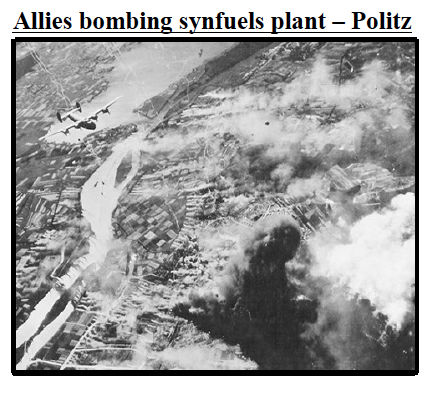
Figure 9
On 16 December 1944, Hitler threw in everything to launch his last counter offensive at the Battle of the Bulge. Although the Germans had the advantage of surprise, they did not have enough resources and the German offensive was finally stopped and pushed back on Christmas Day 1944.
By the end of 1944, German units were operating from one fuel shipment to another and often had to change their preferred operational plans to reduce fuel consumption. In 1945, the Wehrmacht was grounded for lack of fuel and their new Tiger & Panther tanks were running on fumes since at that time the Germans were never more than 30 days away from running completely out of fuel. Thus, the German Army tried to wage a war of mobility but had no mobility due to lack of fuel.
By February 1945, German production of aviation fuel was down to a trickle equaling about 0.5% of the aviation gasoline production during the first four months of 1944.
The fuel shortage at this time made it impossible for the Luftwaffe to properly train new fighter pilots which in turn increased the effectiveness of the allied bomber forces. Thus, the average number of flight training hours for new German pilots dropped 52% from 240 hours in 1942 to only 110 hours in 1944. (note: British and US flight training hours for new pilots averaged about 350 hours). Typically in the last 2 years of the war, German Luftwaffe airplanes were pulled to runways from aviation hangers and parking locations by horses, cows and oxen, as shown in figure 5.
By the end of the war, the German war machine was running on empty.
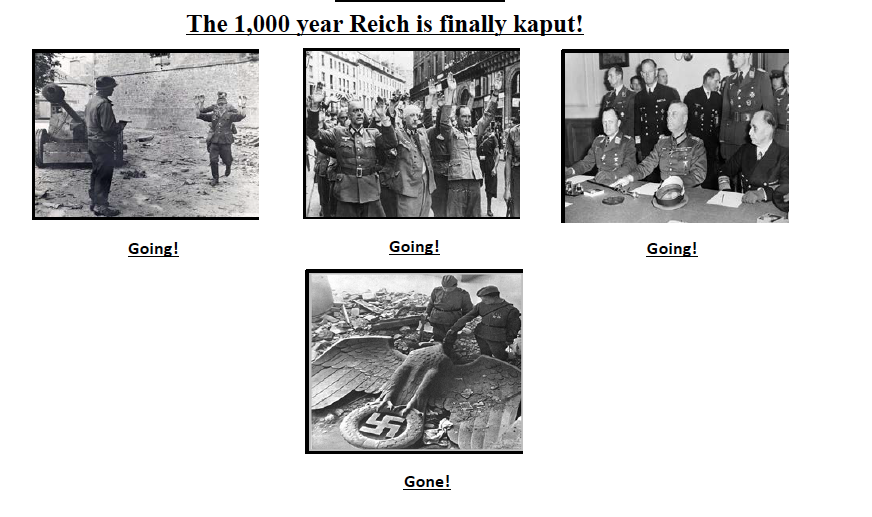
World War II — Japan
Energy supply before World War II
In the 1930’s, Japan was a densely populated country with few natural resources, especially oil. As a result of military victories against China in 1895 & Russia in 1905, Japan gained territory & some related mineral rights. By the late 1920’s, Japan had complete control of Manchuria which became Japan’s life line for many raw materials. After the assassination of a pro-West Japanese prime minister in 1930, an ultra-nationalistic and militaristic government took control of Japan which gave rise to“The Greater East Asia Co-Prosperity Sphere” known in Japan as the “The Imperial Way” (i.e. Asia controlled by Japan).
Under this imperative push for strategic resources, the Imperial Japanese Army focused on: Manchuria, North China, Mongolia and the Soviet Union while the Imperial Japanese Navy was ordered to concentrate on: the Dutch East Indies (i.e. Indonesia), Indochina (i.e. Vietnam) and various Pacific islands. In 1938, Japan imported 106 MBD* but only produced 7% of their domestic and military oil requirements (i.e. 7 MBD with 80% of the balance imported from the USA and 10% from the Dutch East Indies). Furthermore in Japan, 25 oil companies with 37 refineries had only a total distillation capacity of 22 MBD (i.e. 22% of the Japanese demand).
Thus, the balance of their oil demand had to be imported as finished petroleum products (note: By 1940, the USA produced over 3,699 MBD or 63% of the world petroleum production and Japan reached the peak of oil consumption for the next 5 years of war as shown in figure 13.Furthermore, 60% of the internal Japanese petroleum product market was controlled by what is now ExxonMobil (i.e. then known as the Stanvac Company in Japan) and Royal Dutch Shell Oil (i.e. known as the Rising Sun Company in Japan).
With sizeable coal reserves, the Japanese attempted to establish a synthetic fuel industry as did the Germans but failed due to the lack of technical expertise as well as shortages of alloy and catalytic metals required for synfuel production. In recognition of this oil handicap, the Imperial Japanese Navy initially owned and operated its own petroleum refinery to primarily manufacture heavy fuel oil for the fleet in 1921 and added another refinery in 1943.
The Imperial Navy also owned and directly operated its own coal mine in Korea.
On the other hand, the Imperial Army only directly operated 1 refinery which was opened in 1943 as well as a synthetic fuel plant in Manchuria.
Just prior to Pearl Harbor, Japan had enough oil stockpiled for 2 years of normal consumption which represented only a one year supply during war, primarily due to the increased manufacturing.
Over 75% of the aviation gasoline fueling the Japanese planes attacking Pearl Harbor on 7 December 1941 was derived from California crude oil that was refined in Japan as well as on the US West Coast.
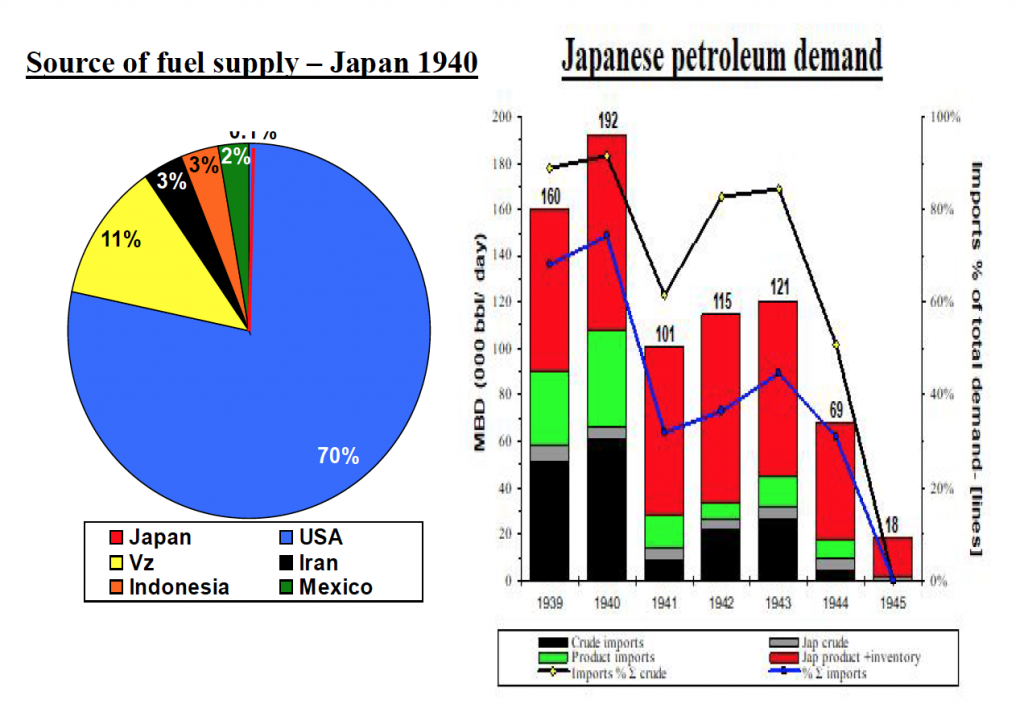
Figure 13
Imperial Japan’s Grand Prize and Strategy
As a result of continued Japanese aggressiveness in Indochina and the Tripartite Pact with Hitler and Mussolini, the US banned the export of steel and scrap iron to Japan in September 1940. The supply of US oil continued to be shipped to Japan until Indochina was invaded in July 1941 when the US imposed a total trade embargo against Japan, including oil, which of course led to the day that will live in infamy on 7 December 1941.
Given nearly total energy dependence on foreign imports, the initial Japanese strategic thrust was to seize and control the oil fields developed by Royal Shell in the Dutch East Indies (i.e. Indonesia) and Borneo which produced 165 MBD in 1940, which equaled the entire oil production in Europe (note: see figure 14).
These areas also contained 90% of the worlds’ natural supply of rubber which was soon controlled by Imperial Japan. Indochina (i.e. Vietnam) and Malaysian were also seized for other crucial resources. Japan assumed the resources in the Southern zone of “The Greater East Asia Co-Prosperity Sphere” would ensure the long term power to maintain a “Pacific Wall.”
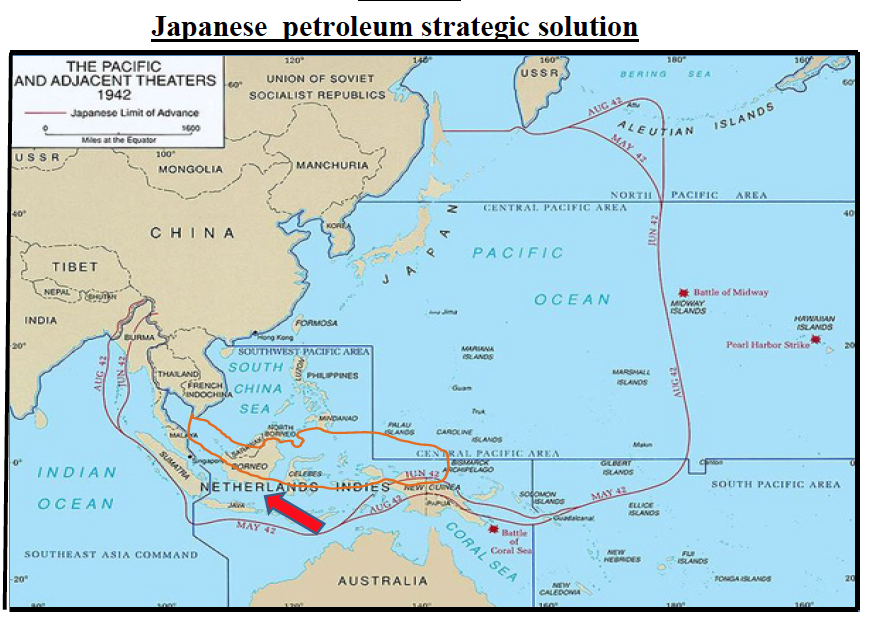
The noose tightens –Japan runs out of oil and is defeated
The first quarter of 1943 was the peak period for oil imports to Japan. The Japanese Navy required at least 18MBD* and the Imperial Army consumed 6 MBD. As a frame of reference, the US fuel demand for the war in the Pacific was 46 MBD in 1942, 77 MBD* in 1943 which became significantly higher in 1944 and 1945. In 1944, the petroleum supply chain for Japan was cut in half and completely dried up by 1945 due in large part to US submarines targeting the Japanese merchant fleet, including tankers. 56% of Japanese ships were sunk due to aerial bombs or submarine launched torpedoes.
In fact, US submarines in the Pacific were responsible for over 50% of all marine vessels sunk during World War II. On the other hand, Japanese submarines targeted war ships which turned out to be strategically ineffective. In 1943, the oil production under Japanese conquered territories was 132 MBD* but only 46MBD* (i.e. 35%) actually made it to Japan courtesy of the US Submarine Force. Furthermore after the Japanese seizure of the Netherland East Indies in 1942, many of the oil facilities were sabotaged and took a long time to be brought back to full production. In addition, an American sub sank a Japanese cargo ship which by chance happened to be transporting a significant amount oil production equipment and expert personnel.
As a result of the sinking of tankers by US submarines, the Japanese refineries were extremely short of crude oil so the US bombing campaign of Japanese refineries generally did not need to be started in earnest until 1945. Subsequently, the US Army Air Corps destroyed more than 66% of the total refinery crude capacity, particularly after the recapture of the Philippines and Okinawa.
The resulting shortage of aviation gas forced a significant reduction in aviation operations and pilot training hours, including the elimination of navigation courses and the development of kamikazes with only enough fuel provided for a 1 way trip.
Unlike the US, the Japanese did not return skilled pilots to train at flight schools but kept them in the front line units.
The lack of fuel by the Japanese also significantly affected their loss of the Battle of Leyte Gulf.
The Japanese made at least the following strategic crucial errors during World War II:
1. Failing to send a 3rd attack wave on Oahu to destroy the oil reserves of the Pacific fleet, despite the fact that oil availability was a key reason for the Japanese decision to go to war;
2. Attacking Pearl Harbor and not destroying the US carriers which were at sea on maneuvers;
3. Underestimating the subsequent effectiveness of US submarines to intercept Japanese oil supplies from the Dutch East Indies;
4. Grossly underestimating American resolve, manpower, industrial base, resources & technology;
5. Myopically overlooking the US intelligence skills such as cracking the Japanese diplomatic “Purple” code.

Oil and War: Retrospective
Unlike World War 1, the major military inventions of World War II were not oil powered such as: radar, ballistic missiles and the atomic bomb. Furthermore as shown in figure 18, the USA was energy self-sufficient and the leading crude oil producer in the world in the 1940’s and supplied more than 85% of all the oil used by the Allies during World War II (i.e. 6 billion barrels which equaled the volume of all US oil produced from Drake’s initial well in 1859 up to and including 1941). In 1940, the entire Middle East only produced 204 MBD of crude
As shown in figures 13, the USA was also the largest consumer of petroleum at the start of World War II (i.e. 3,665 MBD compared with the USSR (501MBD), UK (208 MBD*), Japan (192 MBD and Germany (170 MBD).
Without American oil, World War II would not have been won by the Allies (note: see figure 10).
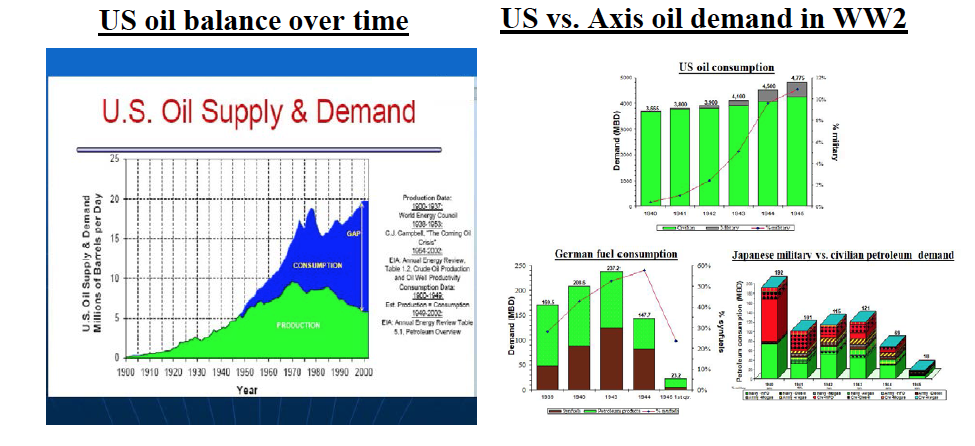
Six months before the attack on Pearl Harbor, President Roosevelt established the Petroleum Industry Council for National Defense and appointed Ralph Davies, a Vice President of Standard of California (i.e. now Chevron) to lead this group which forged an exemplary and successful working relationship between the government and the oil industry during World War II.
For years, toluene had been a byproduct of coke production but Standard Oil (i.e. now ExxonMobil) greatly expanded their production of toluene from crude oil. 49% of toluene produced for the allies during the World War II was refined by ExxonMobil and 15% came from Shell Oil (note: toluene is a key component of TNT used in explosives).
Despite the Japanese monopolistic control of 90% of the world’s natural rubber during World War II, the US allies never suffered from a shortage of rubber also thanks to the manufacture of butadiene from crude oil by the US oil industry, in particular Standard Oil of NJ (i.e. now ExxonMobil) which led to development of synthetic rubber.
The US oil industry continued to push the technology envelope during World War II with several processes enhancements such as hydrofining which yielded a prodigious amount of gasoline but also provided the gateway to make 100 octane avgas that provided allied fighter planes with a technological advantage over the Luftwaffe and Imperial Japanese aviation units. This fuel advantage was especially critical in the “Battle of Britain” where the technologically inferior British Spitfire fighter planes had a distinct power thrust advantage over the more advanced and numerous German Messerschmitt planes.
The initial drive for higher octane gasoline was particularly driven in the late 1930’s by the Vice President of Aviation Products at Shell Oil (US) named James Doolittle. This dynamic leader had maintained his aviation skills during World War I by joining the Army Air Corps Reserve. He was recalled to active duty in July 1940 as a major in the US Army Air Corps and later led the famous Tokyo Raid in 1942 for which he received the Medal of Honor. After the war, he led various key US government commissions & was later promoted to 4 star general in the US Air Force Reserve before his death in 1973 at the age of 96.
One of the most significant and under-reported positive petroleum developments for the Allies during World War II was the design , construction and rapid completion of the “Big Inch” and the “Big Little Inch” pipelines which moved crude or finished petroleum over 1,400 miles from Texas to New Jersey. The 24 inch Big Inch Pipeline was started in August 1942 and completed 12 months later to carry crude oil to the Northeast refineries (note: see figure 20).
The Big Little Inch pipeline was 20 inches in diameter and delivered finished petroleum products to various break out product terminals along the way to New Jersey. When completed with no environmental road blocks, both of these pipelines greatly reduced the number of German submarine attacks as evidenced by the following dramatic reduction in the number of tankers sunk by U-Boats: 1942 = 97, 1943 = 21, 1944 = 6 & 1945 = 2.
In addition, the demise of the initial U-boat turkey shoot was also aided by improvement in convoy tactics as well as Anti-Submarine Warfare technology and sailor sonar skills. The “Big Inch” carried over 334 MBD of crude oil to the Northeast refineries and 240 MBD of finished product (i.e. gasoline, heating oil and diesel fuel) to the military and East Coast markets in the US. As a result of the above 2 pipeline marvels of transportation, the finished and crude petroleum shipped was the equivalent of almost 1,500 tanker voyages per year which greatly reduced the number of targets to the Nazi U-boat wolf packs
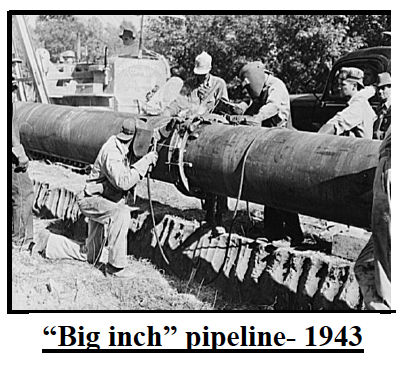
In summary, access to and the distribution of petroleum was an underlying foundation for the Allied victory in World War II, in particular due to:
1. Ample US hydrocarbon resources and refining capacity
2. Close knit cooperation between the USA and the oil industry
3. Significant expansion of oil based toluene production (i.e. a chief component of TNT for bombs)
4. The discovery and manufacturing of synthetic rubber for tires since the raw material was accessible
5. Oil refining technology upgrades for 100 octane avgas used in the Battle of Britain & elsewhere
6. The rapid development and completion of the Big Inch and Little Inch oil pipelines
The next 2 major US combat engagements during the Korean and Vietnam Wars were really not tied to petroleum security of supply. However, some left wing radicals during the Vietnam War incorrectly claimed that the US was really fighting to protect the oil reserves of the “big bad” international oil industry in Vietnam which only has less than 0.3% of the world proven oil reserves which was 94% less than the proven oil in just North America. However, the underlying foundation for Desert Storm on both sides was driven by the control of petroleum resources.
In August 1990, the Iraqi dictator Saddam Hussein had @ 9% of the world proven oil reserve and literally stole another 6% of the total international crude reserves by invading Kuwait. Had Hussein been intelligent which fortunately was not the case, he could have easily whipped down the East coast of Saudi Arabia to pick up another 15% of world oil reserves and then continued to plunder another 6% of total oil reserves in the UAE, Oman & Qatar. Thus, a mad man who was antagonistic to the US would control more than 36% of the global proven crude oil reserves or 50% of the OPEC total oil proven reserves which approaches the dangerous “red zone” known as the “Herfindahl Index” of market concentration.
During Desert Strom, the US was justifiably engaging in international “trust busting” against a clear and present danger to the security of the US and the world.
The current and probably lengthy World Wide War on Islamic Fundamentalist Terrorism is primarily related to a radical and distorted interpretation of Islam to convert through fiendish terror and conquest.
However the objective for ultimate global domination is to control the proven oil reserves in an Islamic Crescent Caliphate from Gibraltar to Indonesia as shown in figure 21, which in turn would contain 54% of the world’s proven crude oil reserve or 75% of all of the oil reserves in OPEC.
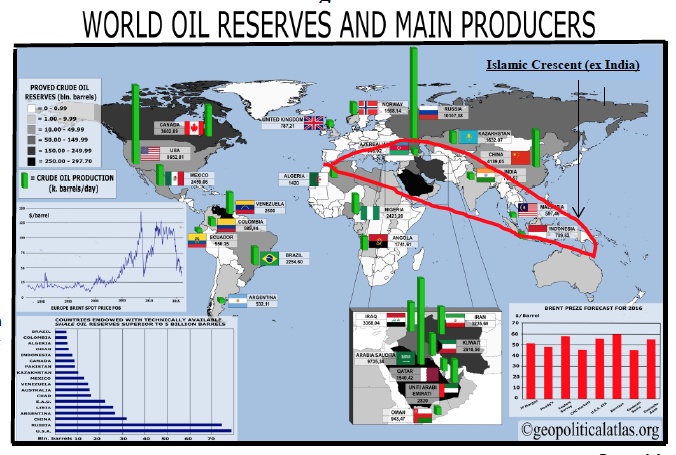
Figure 21
In the hopefully unlikely activation of a future hot war with the Russian Federation, petroleum security of supply will not be a key issue since Russia has 6.3% of the global crude oil proven reserves with a reserve to production ratio (i.e. R/P ratio) of 26 years but only 1.9% of the world’s population.
As a frame of reference, the USA has 3% of the global crude oil proven reserves with an R/P ratio of 11 years and 4.3% of the world’s population.
However petroleum availability will be a key driving force in a future likely hot or cold war with China which has 18% of the world population but only 1.5% of the global crude oil proven reserve with an R/P ratio of 18 years.
As a result, China is now on the attack with a very aggressive global forward presence to address their growing gap for petroleum and other essential resources with a development strategy known as the “Belt and Road Initiative.”
In effect, this strategy by the “Market Leninist” dictatorship of China is an attempt to re-create the ancient “Silk Road” which was a network of routes for commerce that connected the East and the West and named for the lucrative silk trade that started over 200 years before the birth of Christ
The “Belt” in this program stands for the overland routes to China shown with black lines in figure 22 and the “Road” refers to the maritime corridors with a blue line in figure 22 through the South China Sea, the South Pacific Ocean, and the wider Indian Ocean area.

Key objectives of the modern resurrection of these two “Silk Roads” are to enhance the Chinese economic power, regional hegemony as well as petroleum security via infrastructure development and investments in Europe, Asia, Africa and Venezuela.
The Chinese Navy already has established a forward deployment base in Djibouti on the Horn of Africa and is looking forward to using future port facilities that they are building in Pakistan.
The maritime portion of the new “Silk Road” is particularly crucial since over 80% of world trade is carried over the oceans via ships which for the most part are fueled by petroleum.
In addition, over 99% of the transcontinental communications are carried over sea cables in the ocean and food from the sea is expected to increase by an order of magnitude over the next decade.
The Chinese elite and key government officials do study history and view the USA as the gold standard for emulation as a world power.
As a result, maritime leaders and strategists in China are considered to be serious followers of the late Captain Alfred Mahan US Navy who wrote “The Influence of Sea Power upon History” (1660-1787).
Furthermore, China now views the Monroe Doctrine as a concept that should also equally apply to China for dominance over South East Asia which sounds suspiciously like “The Greater East Asia Co-Prosperity Sphere”.
Thus, in the last several years, China has been significantly focusing on the rapid development of their Naval Forces to the point where they are about to have more deployable combat ships than the US Navy (i.e. 350 vice 286) plus more auxiliary and reserve ships than the US (i.e. 700 vs. 200).
However, for the near future, the US still will have a more powerful Navy than the China for at least the following factors:
- Only 1 Chinese carrier vs. 11 US carrier,
- No significant combat experience by the Chinese Navy
- Significantly fewer Chinese naval aviation assets (650 vs. 3,700 planes of the USN)
- Limited forward projection and “Blue Water” experience of the Chinese navy
- Inferior Chinese logistics train, especially for petroleum
In short, relative to the link between “Oil & War”, current and future politicians and military strategists would be wise to remember the following words of Harvard graduate and philosophy professor George Santayana in his 1905 book called Life of Reason: “Those who cannot remember the past are condemned to repeat it”
About the Author
Captain Paul E. Mawn US Navy (Ret.) grew up in Lynn (MA) and was commissioned as a Navy ensign via NROTC after graduating cum laude in Geology from Harvard College. After communications and intelligence training, he qualified as a surface warfare officer initially on the USS Spiegel Grove (LSD 32) and later on the USS Thaddeus Parker (DE 369) and the USS Albert T. Harris (DE 447). Upon release from active duty, Paul continued to serve in the active Navy Reserve for 2 decades in a variety of surface warfare assignments as well as industrial security and petroleum logistics billets. Prior to his retiring after Desert Storm on the deck of the USS Constitution in Boston harbor (i.e. “Old Ironsides”), Captain Mawn was assigned to the CNO Executive Panel (Op OOK) which was an active duty staff directly reporting to the Chief of Naval Operations where he focused on Navy Petroleum related strategy & issues as well as other assigned tasks from the CNO.
Paul received his MBA from Rutgers University and worked in the oil industry in senior line management positions with Exxon and Hess Oil as well as petroleum related consulting projects with Arthur D. Little Incorporated and as a partner with Mercer Management Consulting. Captain Mawn is currently the president of Concord Consulting Group LLC as well as the Chairman of the Advocates for Harvard ROTC. He was awarded the Navy Commendation Medal by the Secretary of the Navy and the Patrick Henry Silver Medal for patriotic service by the Military Order of the World Wars.
Sources: “America’s Bomber Boys Who fought the Air War against Nazi Germany” by Donald Miller, BP energy outlook, EIA Energy Information Administration, ”Freidrich Bergius and the rise of the German synthetic fuel industry” by Anthony Strange, “History of the Great War” by Jonathan Colin, Hong Kong Economic Journal, ”How World War I ushered in the century of oil” by Professor Brian Black, “How important was oil in World War II” by Keith Miller, The impact of German and Japanese Strategy on World War II” by Jiaxuan Lu, ”Oil” in the Pacific War Online Encyclopedia, “Oil and World Power” in American Nation Encyclopedia, “Oil Power” by Keith Reid in the National Petroleum News, “ “Present development of Petroleum Refining” by Takeo Sata in the Bulletin of the Japan Petroleum Institute, “The Prize- the Epic Quest for Oil, Money & Power” by Daniel Yergin, “US Navy Petroleum Strategy” by Captain Paul E. Mawn USN, “Where there Strategic Oil Targets in Japan in 1945” by Manny Horowitz,
*MBD = 1,000 barrels/day (42 US gallons per barrel)
The featured graphic is credited to the following source:
https://www.rappler.com/newsbreak/iq/149535-china-belt-road-initiative

